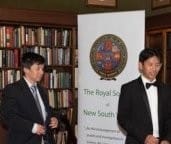
“A drop of optics”
Dr Steve Lee and Dr Tri Phan, joint winners of the 2014 ANSTO Eureka Prize for Innovative Use of Technology
Date: Wednesday 5 November 2014
The talk at the 1227th AGM was presented by Dr Steve Lee and Dr Tri Phan, joint winners of the 2014 ANSTO Eureka Prize for Innovative Use of Technology. They received the award for developing a very inexpensive polymer lens with extraordinarily high resolution that can be used on cameras like those found on mobile telephones.
In recent years, miniaturisation has revolutionised sensors: small image sensors means that the optical device can also be miniaturised and it is much easier to get good optical qualities in a small lens than a large one. The early miniaturised lenses were ground from small pieces of glass and were quite expensive to manufacture. However, with the development of polymers with good optical qualities, high-quality lenses can now be moulded rather than being ground. But if surface tension is allowed to create the lens surface rather than moulding, surface roughness (which is almost impossible to avoid with any moulding process) can be largely eliminated.
A familiar example is the optical quality of raindrops but if the liquid used to form the lens is of much greater viscosity than water, for example, viscoelastic polymers, gravity can be used to shape the surface of the lens to give specific optical properties. The technique that Dr Lee and Dr Phan developed was to use highly viscous polydimethylsiloxane in as the polymer (this is also referred to a silicone polymer) and to suspend droplets from a small orifice so that gravity forms droplets with curvature that has the right optical characteristics. The silicone polymer can be cross-linked and thus stabilise it shape simply by putting it into an oven to cure. Different lens geometries can be obtained by applying several layers of polymer with intermediate curing steps.
One application that Dr Lee and Dr Phan have developed is to use these lenses to clip onto the cameras on mobile telephones. Standard lens on mobile telephone (these are moulded) has a roughness of 200 nm whereas the elastomer lens is around 10 nm. Consequently, much finer detail can be resolved using the polymer lens. The opportunity is to integrate lenses such as these into smart phones and use these for diagnostic and remote sensing applications.
The technology was just released at the Google “The Mobile First World” conference in Taiwan.








